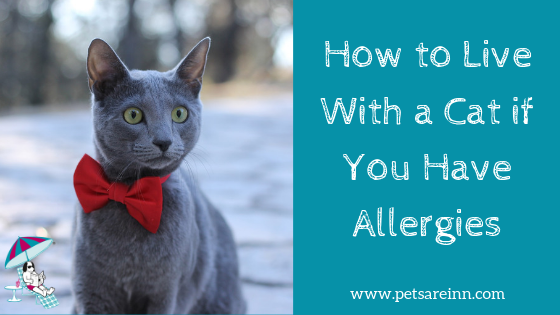Ways to Make It Easier For a Person With Allergies to Live With a Cat
So your a cat lover who is allergic to them.... you would be happy to know there are a few workarounds!
An estimated 10 percent of Americans are allergic to household pets, and cat allergies are twice as common as dog allergies. Most people with cat allergies react to Fel d 1, a protein found on cat skin (although there are other cat allergens as well found on the fur and in saliva).
 The Fel d 1 protein is quite small, so when it’s attached to a piece of airborne cat hair or skin, it can linger in the air for hours – much longer than a dog allergen would typically stay airborne.
The Fel d 1 protein is quite small, so when it’s attached to a piece of airborne cat hair or skin, it can linger in the air for hours – much longer than a dog allergen would typically stay airborne.Meanwhile, the Fel d 1 protein is quite sticky, so it readily attaches to your clothing and skin, and can even be transferred quite easily to public locations that have no cats present, like a school classroom.
Male cats tend to produce more of this allergenic protein than female cats – especially if they’re not neutered. However, all cats produce the Fel d 1 protein, and it’s not related to the amount of dander or shedding.
This means there are no truly hypoallergenic cat breeds. That being said, some cat breeds may be better for pet lovers with allergies than others, and the 10 that follow are said to be among the most “hypoallergenic” of all cat breeds.
10 ‘Hypoallergenic’ Cat Breeds
1. Balinese
2. Russian Blue
The Russian Blue has a short, double coat that is silky and plush to the touch. Like the Balinese, Russian Blues also produce less Fel d 1 protein, making them a better choice for people with allergies. They’re known for their striking appearance just as much as for their loyal and playful personalities.
3. Bengal
Bengals’ fur is uniquely fine, which means it requires less grooming than other cats may require. Since they spend less time licking their fur, it contains less saliva (a common source of cat allergens) and their dander is less likely to be spread around.
4. Devon Rex
5. Oriental Shorthair
6. Cornish Rex
7. Siberian
If you love the look of a long-haired, shaggy-coated cat, the Siberian is it. Fortunately, they also produce less Fel d 1 protein, making them less likely to trigger allergic reactions than other cats, even those with far less fur.
8. LaPerm
The LaPerm cat has a unique curly coat that may help reduce the spread of dander around your home. Many people with allergies do well with LaPerms in their homes.
9. Sphynx
The Sphinx is a hairless cat, which appeals to many allergy sufferers. With no fur to trap allergens from their saliva, they may not cause an allergic reaction as easily as other breeds. Keep in mind, however, that even without fur the Fel d 1 protein will still be present.
10. Javanese
How to Live With a Cat if You Have Allergies
As mentioned, there is no truly hypoallergenic cat, as regardless of coat or shedding tendencies, allergenic proteins may still exist on their skin, saliva, and even in their urine.
That being said, many people find they’re able to build up a tolerance to their kitty over time such that they can live together in harmony. If you’re attempting to share your life with a cat and you have a known allergy, first be sure your allergy is not severe, as you don’t want to trigger a life-threatening reaction.
If your allergy symptoms are more of a nuisance than a serious health threat, here are some options to help minimize your cat allergies at home:
- Consider making your bedroom (or the bedroom of your allergic family member) a cat-free zone. This will help keep allergens out.
- Purchase a high-quality air purifier to help rid the air of allergens and other pollutants.
- To prevent a buildup of allergens inside your home, replace carpeting with hard flooring, replace drapes and curtains with non-fabric window coverings, and if possible, avoid upholstered furniture.
- Clean your home often and thoroughly, including any surfaces that trap pet hair and dander (couch covers, pillows, bedding, and pet beds, etc.).
- Wash bedding at least weekly in hot water.
- Wash your hands after handling your cat, and if the two of you have been snuggling on the couch, consider a shower and shampoo before retiring to avoid bringing kitty allergens to bed with you.
- Feed your cat an anti-inflammatory (grain free), balanced, and species-appropriate diet. Reducing or eliminating the allergenic and genetically modified foods your kitty eats reduces the allergenic quality of her saliva.
- Make sure your cat is getting optimal levels of essential fatty acids in her diet to reduce shedding and dander.
- Bathe your cat regularly, taking care to use only a safe, non-drying herbal animal shampoo.














Comments
Post a Comment